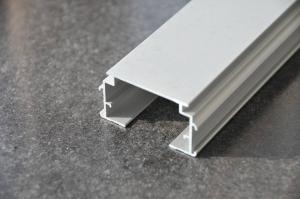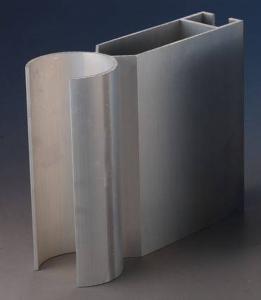Aluminum Extrusion Profiles Section H Cable Tray
- Loading Port:
- China Main Port
- Payment Terms:
- TT OR LC
- Min Order Qty:
- -
- Supply Capability:
- -
OKorder Service Pledge
OKorder Financial Service
You Might Also Like
Aluminium is a relatively soft,durable, lightweight, ductile and malleablemetal with appearance ranging from silvery to dull gray,depending on the surface roughness. It is nonmagnetic and does not easilyignite. A fresh film of aluminium serves as a good reflector (approximately92%) of visible light and an excellent reflector (as much as98%) of medium and far infrared radiation. The yield strength of pure aluminium is 7–11 MPa,while aluminium alloys have yield strengths ranging from200 MPa to 600 MPa. Aluminium has about one-third the density and stiffnessof steel. It iseasily machined,cast, drawn and extruded.
Alu Profile:
Material | Alloy 6063,6061,6005or according to customer’s choice |
Temper | T3, T4, T5, T6 |
Surface | Anodize, electrophoresis, powder coating, PVDF coating, wood grain painting, matted, etc. |
Length | Coating 6.5 meters, Anodizing 6.5 meters, Mill finish 5 meters |
Application | Industrial, electrical equipment(TV set, air conditioner, refrigerator, computer), decoration,construction, transportation |
Custom Made | We can package following with customer's request. |



FAQ:
1. What is the form of payment?
Normally 30% TT, L/C at sight
2. Type of quotation?
FOB, CFR, CIF
3. Port of loading?
Guangzhou/Shenzhen port
4. Delivery time?
15-20 days after client’s deposit
- Q: What are the different bending options available for aluminum profiles?
- Depending on specific requirements and desired outcomes, there are various options available for bending aluminum profiles. Common methods include: 1. Roll Bending: Aluminum profiles can be passed between rollers to achieve the desired bend. This method is ideal for larger and thicker profiles, as it provides a gradual and consistent bend. 2. Press Bending: Hydraulic or mechanical presses can be used to shape the aluminum profile. This method is suitable for both small and large profiles and can achieve different bend angles. 3. Mandrel Bending: By inserting a rod or tube called a mandrel into the aluminum profile, its shape can be maintained during bending. This method ensures precise and uniform bends, making it suitable for complex shapes and tight radius bends. 4. Stretch Bending: Controlled stretching forces are applied to the aluminum profile, allowing it to flex and bend. This method is often used for profiles with large radii and gentle curves. 5. Rotary Draw Bending: Using a die and a rotating arm, the aluminum profile can be bent around a specific radius. This method is highly accurate and commonly used for precise and repeatable bends. 6. Heat Bending: Applying heat to the aluminum profile softens it before bending. Once the desired bend is achieved, the profile is cooled to retain its new shape. This method is suitable for profiles with complex shapes and sharp angles. Each bending option has advantages and limitations, and the selection depends on factors such as profile size, shape complexity, bend angle, and required precision. It is recommended to consult with a professional or bending specialist to determine the most appropriate method for specific aluminum profile applications.
- Q: What are the aluminum profile markets in Cangzhou, Renqiu?
- They all answered, "I tell you, ah, play, huh?"Choose me as the best, hey!
- Q: What are the recycling capabilities of aluminum profiles?
- Aluminum profiles have excellent recycling capabilities. They can be easily recycled without losing their quality or properties. The recycling process involves melting the profiles down, removing any impurities, and then casting them into new shapes or products. This recycling process can be repeated indefinitely, making aluminum profiles a highly sustainable and eco-friendly material.
- Q: Is it possible to recycle and reuse aluminum profiles?
- <p>Yes, aluminum profiles can be recycled and reused. Recycling aluminum is an efficient and environmentally friendly process, as it requires significantly less energy compared to producing aluminum from raw materials. Recycled aluminum maintains its properties, making it suitable for various applications. The recycling process involves melting the aluminum, which can then be reformed into new profiles without losing its strength or quality. This practice reduces waste and conserves natural resources, contributing to sustainability efforts.</p>
- Q: What are the strategies to reduce the environmental footprint when utilizing aluminum profiles in construction projects?
- <p>To minimize the environmental impact of using aluminum profiles in construction, consider the following strategies: Use recycled aluminum whenever possible, as it requires significantly less energy to produce than new aluminum. Opt for energy-efficient manufacturing processes and choose suppliers with strong environmental credentials. Design for disassembly and recycling to facilitate the reuse of aluminum profiles at the end of their life. Implement sustainable construction practices that reduce waste and emissions. Finally, educate stakeholders about the importance of sustainable materials and encourage the adoption of eco-friendly practices throughout the construction process.</p>
- Q: Can aluminum profiles be used in construction?
- Indeed, construction can benefit from the utilization of aluminum profiles. This material boasts properties such as being lightweight, durable, and resistant to corrosion, thereby rendering it suitable for a multitude of construction purposes. Common applications encompass the construction of windows, doors, curtain walls, and roofing systems. Notably, the versatility of aluminum profiles permits the realization of intricate designs and structures. Furthermore, it is crucial to acknowledge that aluminum is an eco-conscious option for construction endeavors due to its high recyclability.
- Q: How do you ensure proper insulation with aluminum profiles?
- To guarantee effective insulation when using aluminum profiles, there are several crucial steps that can be taken: 1. Incorporate thermal break technology: Opt for aluminum profiles that feature thermal break technology. This entails inserting a non-conductive material, such as polyamide, between the inner and outer aluminum sections. This method effectively minimizes heat transfer and enhances insulation properties. 2. Ensure proper sealing: Make certain that the aluminum profiles are adequately sealed during installation. This involves utilizing top-quality sealants and gaskets to prevent air leakage and establish a tight seal. Special attention should be given to corners, joints, and other potential areas where air infiltration may occur. 3. Choose double or triple glazing: When utilizing aluminum profiles for windows or doors, consider using double or triple glazing. This technique involves incorporating multiple layers of glass with an air or gas-filled space in between. This additional insulation layer significantly reduces heat transfer and improves energy efficiency. 4. Opt for insulated frames: Give thought to using aluminum profiles with insulated frames. These frames contain a layer of insulation material within them, further decreasing heat transfer and enhancing thermal performance. 5. Utilize thermal insulation accessories: Enhance insulation properties and minimize thermal bridging by incorporating additional thermal insulation accessories, such as thermal breaks, insulation tapes, or foam inserts. These accessories can be installed within the aluminum profiles. 6. Employ proper installation techniques: Ensure correct installation of the aluminum profiles by adhering to the manufacturer's guidelines and recommendations. This entails using appropriate fasteners, avoiding gaps or spaces, and ensuring proper alignment and fit. By implementing these measures, effective insulation can be achieved with aluminum profiles. This results in improved energy efficiency, reduced heat loss or gain, and increased comfort within buildings.
- Q: Are aluminum profiles suitable for use in roofing or wall systems?
- <p>Yes, aluminum profiles are commonly used for both roofing and wall systems due to their durability, corrosion resistance, and lightweight properties. They offer a modern aesthetic and can be easily integrated into various architectural designs. Aluminum profiles are also known for their strength and flexibility, allowing for the creation of complex shapes and structures. Additionally, they require minimal maintenance and can withstand harsh weather conditions, making them a popular choice for construction projects.</p>
- Q: Is it possible to utilize aluminum profiles as a component in systems designed for covering interior walls?
- <p>Yes, aluminum profiles can be used for interior wall cladding systems. They are lightweight, durable, and resistant to corrosion, making them an ideal choice for both residential and commercial applications. Aluminum profiles are easy to install and can be used in conjunction with various materials such as glass, stone, or wood to create a sleek and modern look. They are also customizable, allowing for a wide range of design options and can be powder-coated or anodized for different finishes and colors to match any interior design scheme.</p>
- Q: This question asks about the impact of aluminum profiles on the longevity and strength of a building structure.
- <p>Aluminum profiles significantly enhance the durability of a building due to their high strength-to-weight ratio, excellent resistance to corrosion, and low maintenance requirements. They are lightweight yet strong, making them ideal for load-bearing structures and facades. Corrosion resistance means they withstand harsh weather conditions without rusting, which is common in steel profiles. This durability extends the building's lifespan and reduces the need for frequent repairs or replacements, thereby providing a cost-effective long-term solution. Additionally, aluminum profiles can be easily recycled, contributing to sustainable construction practices.</p>
Send your message to us
Aluminum Extrusion Profiles Section H Cable Tray
- Loading Port:
- China Main Port
- Payment Terms:
- TT OR LC
- Min Order Qty:
- -
- Supply Capability:
- -
OKorder Service Pledge
OKorder Financial Service
Similar products
Hot products
Hot Searches
Related keywords


























